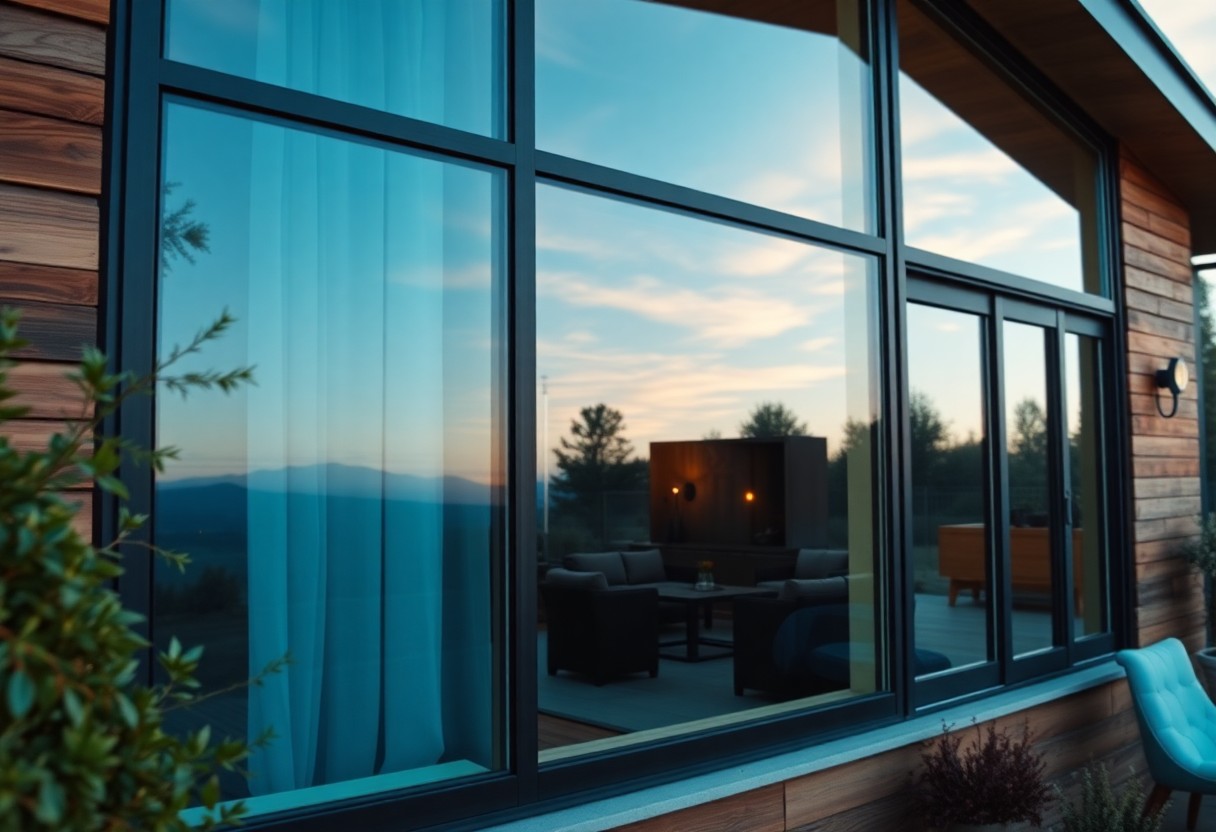You may be surprised to learn that window tinting offers significant benefits for your home in Wittmann. Not only does it enhance your privacy, shielding your family from prying eyes, but it also improves energy efficiency by reducing heat gain and glare. By choosing the right window film, you can create a more comfortable living environment while lowering your energy bills. In this blog post, we’ll explore the various types of window tinting available, their advantages, and how they can transform your living space.
Benefits of Window Tinting
Before you consider upgrading your windows, it’s important to recognize the numerous benefits that come with window tinting. Not only does it enhance the aesthetic appeal of your home, but it also offers increased privacy, energy savings, and UV protection, making it a smart investment for any homeowner.
Enhanced Privacy
For homeowners seeking a greater sense of security and solitude, window tinting provides an effective solution. It allows you to enjoy your living space without feeling exposed, as it hinders the view into your home from the outside while still letting natural light in.
Increased Energy Efficiency
The energy efficiency of your home can significantly improve when you choose window tinting. By reducing the amount of heat that enters your rooms, window films help maintain a comfortable indoor temperature while lowering your reliance on air conditioning systems.
Privacy and energy efficiency go hand in hand when you install window tinting. By blocking a substantial amount of solar heat, the film not only keeps your interiors cooler but also reduces the workload on your HVAC system. This translates to lower energy bills and a more sustainable home environment, making window tinting a wise decision for long-term savings and comfort.

Types of Window Tints
It is important to understand the various types of window tints available for your home. Each type offers unique benefits and can cater to your specific needs regarding privacy and energy efficiency. Here are some types to consider:
| Reflective Tints | Reduces glare and enhances privacy |
| Non-reflective Tints | Maintains visibility while reducing heat |
| Dyed Tints | Effective for UV protection |
| Metalized Tints | Adds durability and heat rejection |
| Ceramic Tints | High performance without reflectivity |
This variety allows you to select the best option that fits your home’s aesthetic while improving its energy efficiency and privacy.
Reflective Tints
Among the popular choices, reflective tints stand out for their ability to reduce glare and enhance privacy during the day. This type of tint has a metallic finish that reflects sunlight, making it more challenging for outsiders to see in while maintaining a clear view from the inside out.
Non-reflective Tints
Any homeowner looking for effective window protection should consider non-reflective tints. These tints offer the advantage of reducing heat without the mirrored effect commonly associated with reflective films.
Understanding non-reflective tints allows you to appreciate their benefits in terms of aesthetics and functionality. With these tints, you can enjoy enhanced UV protection while preserving your view. They work by absorbing heat rather than reflecting it, making them an excellent choice for properties where exterior appearance is important. Non-reflective tints maintain your home’s natural light, providing comfort while subtly improving privacy.
Installation Process
Clearly, the installation process of window tinting involves careful preparation and execution to ensure optimal results. Before applying the film, it’s vital to clean your windows thoroughly to eliminate dust, dirt, and oils that could affect adhesion. Once your windows are prepped, measurements should be taken accurately, followed by cutting the film to fit your specific window dimensions. Finally, applying the tint requires precision and attention to detail to avoid bubbles and wrinkles, resulting in a professional finish.
DIY vs. Professional Installation
Professional installation often guarantees a high-quality finish and longevity, as experts have the experience and tools necessary to apply the tint correctly. While DIY installation is an option for those with a steady hand, it can lead to unsatisfactory results if not done properly. By choosing a professional, you also minimize the risk of damaging your windows, ensuring both aesthetic and functional benefits.
Steps for a Successful Installation
The process for a successful window tint installation includes several key steps. Start by gathering the necessary tools such as a squeegee, utility knife, and measuring tape. Next, measure your windows and cut the tint film accordingly. After cleaning your windows, carefully apply the film from one edge to the other, using the squeegee to eliminate air bubbles. Lastly, trim any excess film and inspect the installation to ensure a flawless appearance.
A successful window tint installation hinges on proper preparation and technique. Begin by gathering your tools and choosing high-quality film that meets your needs. When measuring your windows, allow for a slight margin to ensure a perfect fit. Cleaning is vital, as any debris trapped under the film can cause imperfections. Once the film is applied, use the squeegee methodically, working from the center outwards to avoid air pockets. After trimming excess film, give your work a final review, checking for any remaining bubbles or misalignments, ensuring your tint looks flawless and performs effectively.
Maintenance of Window Tint
Once again, proper maintenance of your window tint is imperative to ensure its longevity and effectiveness. Routine care can help you maintain optimal privacy and energy efficiency in your home. By following the right practices, you can keep your tinted windows looking great for years to come.
Cleaning and Care Tips
Below are some helpful cleaning and care tips to maintain your window tint:
- Use a soft, non-abrasive cloth for cleaning.
- Opt for a mild soap solution or a dedicated window tint cleaner.
- Avoid ammonia-based products as they can damage the tint.
- Clean your tinted windows regularly to prevent dirt build-up.
Any care taken will help in preserving the clarity and performance of your window tint.
Signs of Wear and Replacement
Behind every well-maintained window tint is the ability to identify wear and know when to replace it. Regular inspections can save you from diminishing privacy and energy efficiency.
Understanding the signs of wear on your window tinting is key to maintaining your home’s privacy and energy efficiency. Look out for issues such as peeling edges, bubbling, or discoloration. If you notice any of these signs, it may be time to consider replacement. Early detection and action can help you avoid a decline in the performance of your tinted windows and ensure your home remains comfortable and energy-efficient.
Legal Considerations
Keep in mind that window tinting regulations can vary greatly by location, so it’s important to familiarize yourself with local and state laws before proceeding with your installation. Understanding these legal considerations will ensure your home remains compliant while you enjoy the benefits of enhanced privacy and energy efficiency.
Local Regulations in Wittmann
Around Wittmann, window tinting laws dictate the allowable levels of tinting for residential properties. These regulations address factors such as the visible light transmission percentage and reflective properties, helping to maintain aesthetic harmony in the community. Before applying tint, check with local authorities to ensure compliance with these regulations.
Compliance with HOA Rules
Any home that is part of a Homeowners Association (HOA) should consider the specific rules regarding window tinting, as they often have additional standards to maintain property values and uniformity within the neighborhood.
Further, your HOA may require you to submit an application or seek approval before installing window tinting. This can include providing samples of the tint or detailing its specifications. By adhering to HOA rules, you not only avoid potential fines but also contribute to maintaining the visual appeal of your community. It’s wise to consult your HOA’s guidelines and possibly reach out for clarification to ensure your window tinting project aligns with their expectations.
Cost Analysis
After considering window tinting for your home in Wittmann, it’s imperative to evaluate the overall costs involved. The initial investment may seem daunting; however, understanding this expense in the context of long-term savings on energy bills and increased property value can provide a clearer financial picture. Additionally, the benefits of enhanced privacy and protection can outweigh the upfront costs, making window tinting a wise choice for improving your home’s efficiency.
Initial Investment vs. Long-term Savings
Analysis of window tinting your home reveals that while you will encounter an upfront expense for the materials and installation, the long-term savings on energy costs can be substantial. By blocking harmful UV rays and reducing heat loss, you can enjoy a more comfortable living environment and lower energy bills, effectively making your investment pay off over time.
Factors Influencing Cost
Behind the cost of window tinting, several factors contribute to the overall price you may pay. These include the type of tint selected, the size and number of windows, and labor costs associated with installation. Additionally, regional pricing differences may impact your total investment. Factors to consider include:
- Quality of the window film
- Size and architectural complexity of your windows
- Local labor rates for professional installation
Recognizing these elements can help you make an informed decision on the best tinting solution for your home.
This analysis of the factors influencing cost can guide your understanding of window tinting prices. You should also keep in mind that opting for high-quality materials and professional installation may lead to higher initial costs but can enhance durability and efficiency in the long run. Important considerations are:
- The warranty provided by the tint manufacturer
- The potential for tax incentives or rebates in your area
- Your personal preferences for aesthetics and functionality
Recognizing these factors will empower you to make better choices regarding window tinting that align with your budget and needs.






Can you be more specific about the content of your article? After reading it, I still have some doubts. Hope you can help me.